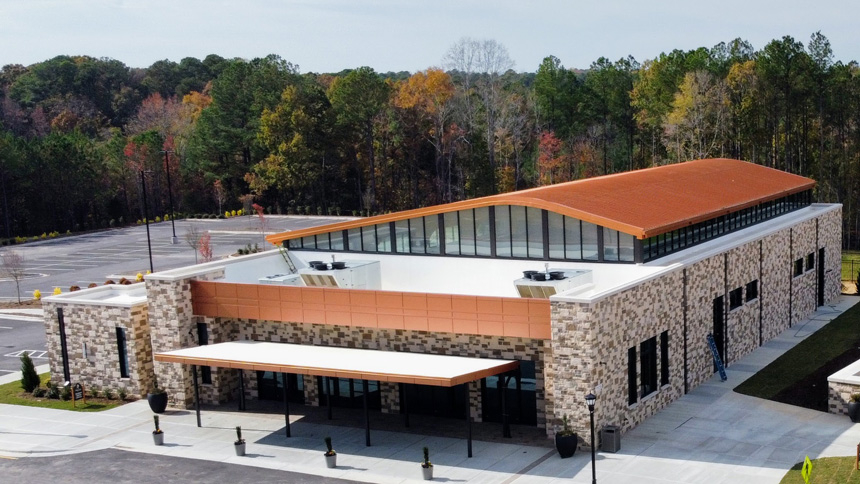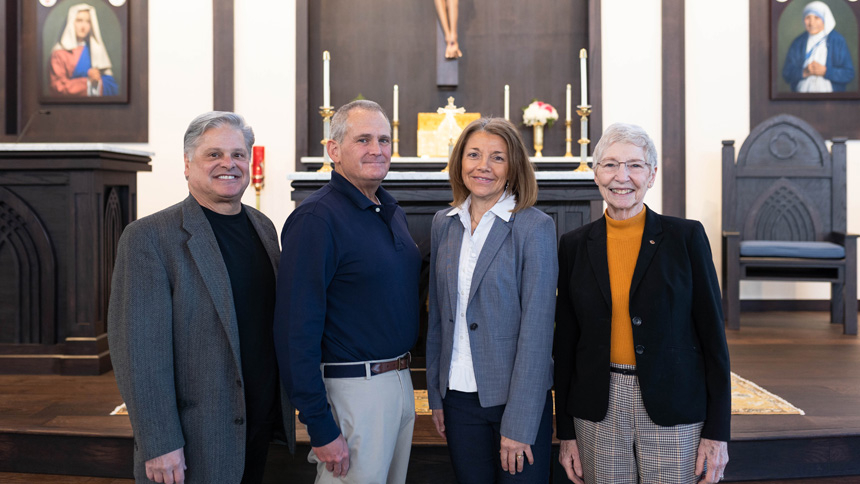
Above, left to right: Jeff Vittert, Matt Young, Jean Fuccella and Judy Adkins were part of the team that helped a community of Catholics become a parish with a new building dedicated at the end of 2022.
St. Teresa Church in Cary has new worship space, pastor and distinction
For years, the congregation of what is now St. Teresa of Calcutta Church was on a mission -- to be recognized officially as a parish. They began as some other small Catholic communities do, as a mission church under the guidance of a larger parish.
Their prayers were answered in January 2023.
The path toward becoming a parish wound through 22 years of challenges and blessings; yet during that time, the people became more than a church-going congregation.
They became a family.
A church is more than four walls and a roof
The congregation’s journey began in earnest on August 20, 2000, when Monsignor John Wall, then pastor of St. Michael the Archangel Church in Cary, presided at the first overflow Mass held in the Green Hope High School auditorium. Seventeen people attended. Among them was Jean Fuccella, who volunteered to set up for the first Mass.
From then on, Jean was a fixture — and a force to be reckoned with. She became a leader in the fledgling community and wasn’t shy about asking people to help.
“At first, I grabbed people and said this is what you are going to do today,” Jean laughed, “but by the time we’d been going several months, I had people who said, ‘Well, I’ll just handle that from now on.’”
Matt Young was one of those people. He attended the second Mass at Green Hope and had barely gotten in the door before Jean asked him to be an usher and Eucharistic Minister. He became a regular, helping prepare for Mass, playing guitar and singing in the choir.
“It was kind of like slow boiling water,” Matt said. “When we started, none of us knew what we were doing. But because the numbers of people grew so slowly over the course of 22 years, we figured out how to do things.”
This culture of service grew steadily. Helping and welcoming are now hallmarks of the congregation. Of the 515 current registered families from diverse populations, 275 people are active volunteers. Matt considers that an under count.
“Volunteering is in a certain sense part of being a member of the parish,” Jean said. “I was always watching out for people and taking a few minutes to talk with them, find out who they were, where they came from, what strengths they might have that they would be willing to share.”
The personal approach worked. Matt has a background in marketing; he started writing the bulletin and managing communications. Judy Adkins has a background in childhood education; she volunteered to start the Children’s Liturgy of the Word and runs the mission ministry for Uganda. Jeff Vittert had experience with commercial project development; he became volunteer project manager overseeing the building of the new worship center.
“We not only got volunteers to do the mundane weekly things that you just have to do, but we got a children’s choir started out of that,” Jean said.
Two Masses on Sunday required significant setup and take down, including cleaning the auditorium and cafeteria after events. At Easter and Christmas, Mass attendance swelled to around 1,000. Rental chairs had to be set up and put away, and 70-80 people would come early to help.
And when the time came to clear the land that would eventually become the site of St. Teresa’s worship center, the call for volunteers went out. A crew of 50 people showed up to cut grass and clear shrubs. Boy Scouts then built outdoor stations of the cross on the property.
“We called ourselves a Catholic church, and unofficially we really were,” Matt said. “We were self-sufficient. We helped each other.”
Providentially, the layout of Green Hope High School enhanced opportunities for service and fellowship.
Mass attendees passed through the cafeteria to and from the auditorium for Mass. They began stopping on the way out for coffee and doughnuts once a month. Events, like the Chili Cook-Off, encouraged more fellowship. Information tables - eventually as many as 20 - advertised service opportunities with groups such as Project Rachel, altar guild and St. Matia Mulumba in Uganda. The volunteer leads of each activity were at the table to answer questions.
“We called it the market square,” Matt said.
For Judy Adkins, such community is essential.
“’All are welcome’ is part of our mission. You can’t do all of this unless you have a lot of hands, and we had a lot of hands,” Judy said. “They came not only to serve God, but for the social aspects of it, because they got to know each other. They were Christ to each other. They supported each other through various events in each other’s lives.”
Service in the spirit of Mother Teresa
Following in the footsteps of Mother Teresa, that support overflows to many community programs as well.
Until 2015, when Father Daniel Oschwald (now pastor) was assigned to the mission church, different priests came to Green Hope each week to preside at Mass. That’s how the congregation met Father Charles Lugenda and built a relationship with his home in Uganda.
“We knew that there was a great need in Uganda for supporting children who were at a disadvantage with their school tuition, uniforms, food and pencils,” Judy said.
In response, the Children’s Liturgy of the Word group assisted in an Advent Calendar fundraiser.
“We’re thinking maybe we’ll raise a couple of hundred dollars. That will be fine and dandy,” Judy said. “But we raised thousands of dollars, and so that’s how it began.”
Support has been flowing ever since, including raising money for water supply infrastructure, solar panels, construction projects and a car for the parish. The Green Hope congregation became a safety net for St. Matia Mulumba in the pandemic, raising $20K for emergency food relief.
Care for the congregation in Uganda reflects an openness to diversity at St. Teresa Parish. Parishioners include people from India, Vietnam, Malaysia and other countries. Over the years, the congregation has held Mass to celebrate those cultures, with members of a particular community in charge of planning. An effort was made to engage a priest from that area to preside. A buffet of local foods would follow in the cafeteria.
“We ate awfully well,” Jean laughed. “It was another thing that pulled the community together. It wasn’t like, ‘well they’re over here, and we’re over here, and another group’s over there.’ No. We were one community.”
Building a parish home
When it finally came time to plan the space for a new worship center, the congregation’s history and culture of service weighed heavily in the considerations.
In 2019, Jeff Vittert joined the Building and Land Use Committee of parish volunteers, who put a lot of thought into the planning and design of the new building. Bishop Luis Rafael Zarama dedicated the new worship center in November 2022.
“It is a multi-use space, but we wanted it to feel warm, inviting, and also to feel like a religious, a holy space,” Jeff said.
Leaders said the plan was to use the multi-use space as a worship area for now, while planning for church on the same campus. Once the church is built, the multi-use space will become a parish center.
Critical to the community was retaining the “marketplace” feeling they created in the Green Hope cafeteria, so a large narthex in the new building accommodates fellowship activities, information access and volunteer opportunities. The narthex is separated by a glass wall from the worship space and is wired into the sound system so it can accommodate overflow.
The asymmetrical arch of the wooden roof and ceiling flows over the space in the shape of a wave or wing. Large windows extend down from the ceiling to let in light and frame the trees outside. Supporting the roof are wooden arch beams and columns. The floor is carpeted, and the worship area is furnished with upgraded chairs that are comfortable yet allow flexibility to host bigger events.
“To me it conveys warmth. It’s open. A lot of natural light comes in. It’s inviting … and comfortable,” Jeff said. “The wood structure reflects warmth and strength, and those were some of the principles we were trying to achieve in the space as a reflection of our community and as a reflection of Mother Teresa. We hope it is a space she would be proud of.”
Typical of the congregation’s focus on service and diversity, key features of the space were created by parishioners. Michelle Eckhart designed the reredos behind the altar. Harry Chalker’s company helped with much of the interior design and furnishing. John McGuire built the sanctuary furnishings. The indoor stations of the cross were created by Ed DelCogliano. Bill Gurecki painted the portrait of Mother Teresa that hangs in the narthex. The Gratitude Tree in the narthex was made by Dan Fuccella, assisted by Ashley Steinlage.
For Father Daniel, the sharing of talents by congregation members is just one more thing that adds to the feeling of being home in the new worship center and parish.
“Think about this. For 22 years no tabernacle. For 22 years every time we finished Communion you had to collect the leftover Eucharist, put it in a box and transport it home or to St. Michael,” he said. “We were ever so grateful to be able to finally say ‘this is home.’”
Jean Fuccella, who traveled along from the beginning of the journey, is also grateful.
“It’s a dream come true,” Jean said. “I’d known in my own heart for a long time that it was going to eventually happen. It’s beautiful and we are so grateful to have it. To have our own place after 22 years is just magic. It’s a gift from God.”
NC Catholics NOW
NCCN traveled to Cary for the Dec. 10 dedication of the new worship space for Mother Teresa Mission. Watch and listen to volunteers and Father Daniel Oschwald, who speak about the road from the community forming in 2000 to 2022.



